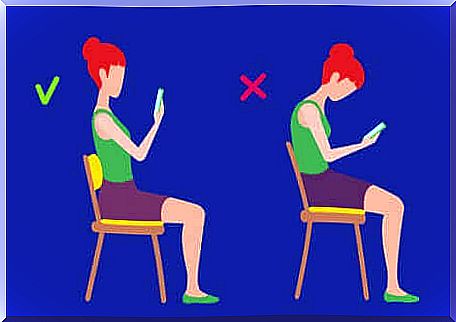Tech-neck: Why Does It Occur And How To Avoid It?

Have you heard of the teak-neck ? The use of new technologies has become more and more anchored in our daily lives. Almost all of us use phones, laptops and tablets every day, whether for business or pleasure.
However, we do not always make good use of it, physiologically and posture. This is where the so-called “technological diseases” come from, of which the tech-neck is one.
Indeed, according to a study published by CBS News, we spend an average of 2 to 4 hours with the neck bent, because of the use of this type of electronic device. This would equate to around 700-1400 hours per year, which can drift into syndromes like tech-neck.
But what is this syndrome and what symptoms does it involve? Why does it appear? This is what we will see in this article.

Tech-neck: what is it and why does it happen?
The tech-neck , also called “syndrome text neck ” is considered a technological disease due to the fact of bending the neck reiterative way when writing messages on his phone. This bad posture, repeated several times a day, can lead to great physical discomfort, like this syndrome.
It also appears when we spend a lot of hours looking at our phone (not necessarily while writing), for example to consult the information, social networks, etc. Therefore, this problem arises due to bad postures and inadequate habits in our daily life.
Symptoms of tech-neck
As we can see, the tech-neck derives from this recurring tilt of our neck when we consult our cell phone (or other similar device). This is a practice that can lead to real problems at the physical level.
Thus, the most characteristic symptoms of tech-neck are neck pain and stiffness, poor posture, headache and sore back. It can also generate other pathologies, such as tendonitis (tendon disorder that causes pain worsening with movement, in addition to inflammation and deterioration of its function).
Thus, this disorder can lead to dysfunctions in the neuro-musculoskeletal system at the cervical level. If the spine is not working properly, joint alignment may be altered, leading to conditions such as a herniated disc, cervical spondylosis, contractures and the symptoms mentioned.
Other related issues
Beyond the tech-neck, excessive use of the thumb can generate stress on the joints as well as other types of ailments. For example: Quervain’s tenosynovitis (a type of inflammation) or rhizarthrosis of the thumb, an arthritis common in women who sew.
Physiotherapists warn
Physiotherapists have sounded a wake-up call to the great wave of tech-neck symptoms they are seeing recently during their consultations. This syndrome is more and more generalized.
Mónica Rodríguez, physiotherapist in Catalonia, explains that more and more people are consulting for this reason. As well as other technological diseases derived from prolonged and inadequate use of smartphones, tablets, laptops and computers in general.
How can you avoid the tech-neck?
How can we avoid the tech-neck ? To avoid the appearance of this problem and other technological diseases, experts recommend the following tips:
- Position the screen of the phone, tablet or computer slightly below the eyes. This will allow the cervicals to come to a neutral, non-flexed position.
- Keep an upright posture, but without forcing.
- When sending messages, prioritize voice notes over writing.
- Use both hands to write, keeping the wrist in a neutral position.
- Sit properly.
- Reduce the time of use of this type of device.
- In the case of computers, position the keyboard and mouse so that the wrist does not close, that is, by supporting the forearms and putting a cushion under the wrist. According to experts, ideally, the keyboard should be at a level lower than elbow height.
- If we are working on the computer, take breaks every thirty minutes.
- Do active stretches that allow us to stretch our wrists.
- Perform active back stretches.

Watch out for little habits
Routine and habits determine health to a large extent. As we have seen, an act as “banal” as consulting your phone can be discouraged for physical but also mental health, because one of the symptoms of tech-neck is headache, for example.
Logically, if we apply the advice given and if we reduce the consumption of this type of device, we can succeed in preventing tech-neck and other “technological diseases”. However, if we have already developed the syndrome, it will be best to consult a physiotherapist to regain our physical and mental well-being.










